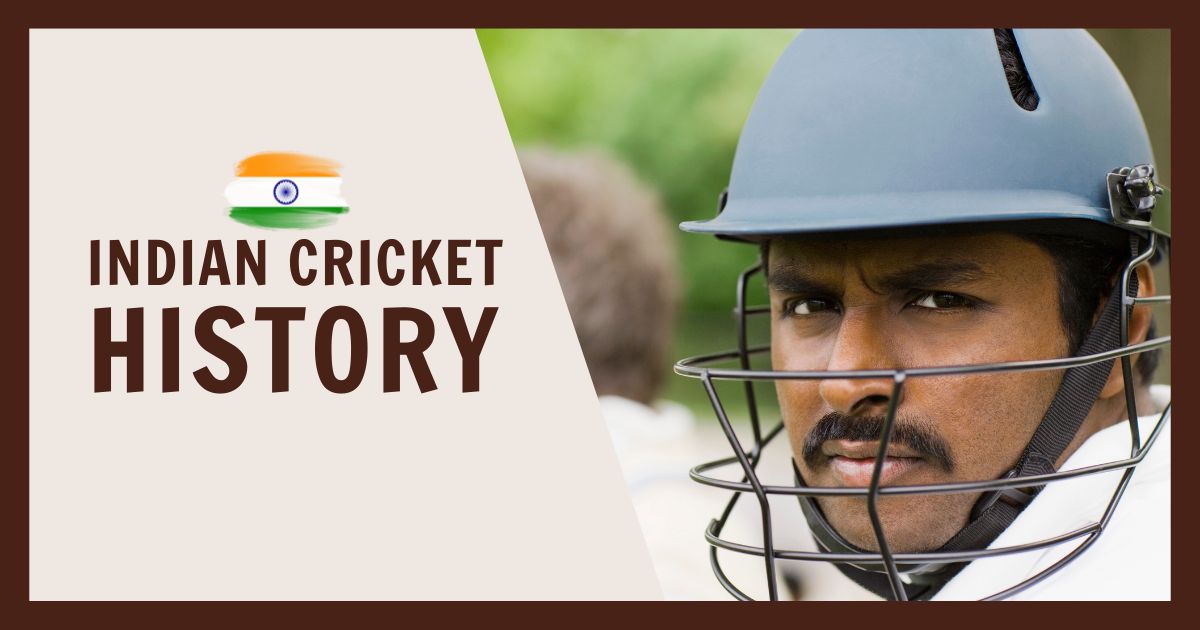The history of cricket in India is a journey like no other. It’s a story of how a simple game became a national obsession, uniting billions of fans across the country.
From its early days under British rule to the modern era of superstar players, Indian cricket is packed with fascinating twists, legendary moments, and some serious cricketing passion!
Get ready to dive into the Indian cricket history, a tale filled with more sixes than you can imagine!
The Indian Cricket History Timeline
Cricket sets sail for India! European sailors introduce the game to the subcontinent, planting the seeds of a future national obsession.
The All India Cricket Team takes the field for the first time in an international match against England. A taste of things to come!
History is made! India enters the big leagues with their official Test cricket debut at Lord’s, England.
After years of hard work, India finally clinches its first Test victory against England in Madras (now Chennai). This win is a sign of India’s growing potential on the world stage.
A giant leap forward! India conquers England on their home turf, etching their name on the global cricketing map.
A watershed moment! Under Kapil Dev’s captaincy, India wins its first-ever Cricket World Cup, igniting a lifelong love affair between the nation and the sport. This win goes beyond the trophy, sparking a national obsession with cricket.
A batting legend emerges! Sunil Gavaskar becomes the first player to score a staggering 10,000 runs in Test matches.
Kapil Dev adds another feather to his cap, becoming the highest wicket-taker in Test cricket history, surpassing Richard Hadlee’s record. This all-rounder has cemented his place in Indian cricket history.
Heartbreak in the World Cup! India reaches the semi-finals but loses to Sri Lanka. Despite the disappointment, their hunger for glory only intensifies.
The “God of Cricket” strikes again! Sachin Tendulkar became the first player to score 10,000 runs in One Day Internationals, reaching a historic milestone.
A defining moment! India defeats the mighty Australians in a historic Test series, known as the Kolkata Test. This victory marks a significant step forward in India’s cricketing journey.
MS Dhoni takes the reins as captain and leads India to victory in the inaugural T20 World Cup. A new era of fast-paced cricket dawns.
India’s dominance continues! They won the Border-Gavaskar Trophy in Australia, becoming the first team to win a Test series there in over 20 years.
The dream is realized once again! India clinches its second World Cup title under Dhoni’s leadership.
A new chapter begins! Virat Kohli takes over as captain, bringing a youthful and aggressive approach to the team.
India reaches the ICC World Twenty20 semi-finals but falls short against West Indies. The quest for another T20 title continues.
India reaches the pinnacle of Test cricket, becoming the number one team in the world, a testament to their consistent performance.
Rohit Sharma takes charge! He became captain across all three formats – Test, ODI, and T20I, leading Indian cricket into a new era.
This is just a glimpse into the incredible history of cricket in India. It’s a story filled with passion, perseverance, and iconic victories that continues to inspire generations of players and fans alike.
Indian Cricket History

Colonial Roots of Cricket in India
The early days of cricket in India were intertwined with British colonialism. The first cricket clubs were established by the British, with matches serving as a social gathering for the elite.
However, the seeds of passion were sown amongst Indians as well. Local clubs were formed, and talented players like Ranjitsinhji (Ranji) emerged, showcasing exceptional cricketing skills.
The Early Days (Pre-Independence)
As India’s fight for independence grew, so did the desire for an independent cricketing identity.
The “Presidency Matches” (Bombay vs Madras vs Calcutta) became a platform for showcasing Indian talent.
The formation of the All-India Cricket Board of Control (BCCI) in 1928 marked a crucial step towards organized cricket administration in India.
The Road to Test Status (1920s-1930s)
The journey to Test cricket was not easy. India faced challenges like racial discrimination and a lack of international recognition. Pioneers like C.K. Nayudu, a charismatic leader and skilled all-rounder, played a vital role in advocating for India’s inclusion in the cricketing world.
India’s unofficial tour to England in 1932, though not granted Test status, showcased their growing potential.
Maiden Test Match and the Quest for Success (1930s-1970s)
India’s historic first official Test match against England at Lord’s in 1932 was a landmark moment. While the initial years were marked by struggles, players like Vijay Hazare and Polly Umrigar displayed grit and determination. The development of India’s famed spin bowling attack, featuring legends like Bishen Singh Bedi and Erapalli Prasanna, became a defining feature of Indian cricket.
The 1983 World Cup – A Turning Point (1980s)
The 1983 Cricket World Cup victory under Kapil Dev’s captaincy was a watershed moment.
Against all odds, a young Indian team, led by Kapil Dev’s inspirational all-round performance, defeated the mighty West Indies to claim the coveted trophy.
This victory transcended the sport, igniting a sense of national pride and ushering in a new era of Indian cricket dominance.
Batting legends like Sunil Gavaskar, known for his technical brilliance, and Gundappa Viswanath, with his elegant strokeplay, further cemented India’s cricketing prowess.
The Modern Era – Domination and Beyond (1990s-Present)
The post-1983 era saw the rise of a new generation of superstars like Sachin Tendulkar, the “God of Cricket,” whose batting records continue to inspire generations. Sourav Ganguly, a bold and aggressive leader, instilled a winning mentality in the team. Rahul Dravid, known for his resilience and impeccable technique, became a role model for aspiring cricketers. Virender Sehwag, with his explosive batting style, redefined opening partnerships.
The introduction of the Indian Premier League (IPL) in 2008 further revolutionized Indian cricket.
The IPL provided a platform for young talent to showcase their skills alongside international stars, fostering a more aggressive and dynamic approach to the game.
India’s recent success in World Cups, including the 2011 triumph under MS Dhoni’s astute captaincy, and consistent performances in all formats solidify their position as a cricketing powerhouse.
Evolution of Cricketing Techniques and Tactics in India

Indian cricket has witnessed a significant evolution in techniques and tactics.
From the emphasis on spin bowling in the early years to the emergence of powerful batsmen and a more aggressive approach in recent times, Indian cricket has adapted to the changing cricketing landscape.
The influence of iconic players like Sachin Tendulkar and the emphasis on athleticism have shaped a well-rounded Indian team capable of excelling in all formats.
The The Greatest Captains In Indian Cricket History
India has been blessed with several exceptional captains who have left their mark on the sport. Each captain brought their unique leadership style and strategies to the table.
Cricket’s Social Impact in India

Cricket in India transcends the boundaries of the sport. It’s a unifying force that cuts across social and cultural barriers, fostering a sense of national identity and belonging.
Cultural Significance of Cricket in India
Cricket matches become national festivals, uniting people from all walks of life in a shared passion. The roar of the crowd, the vibrant displays of team colors, and the collective celebration of victories create a powerful sense of togetherness. Cricket serves as a common language, bridging social divides and fostering a sense of community.
Women’s Empowerment and Cricket
While traditionally a male-dominated sport, cricket is witnessing a rise in women’s participation. The Women’s Cricket World Cup and the establishment of the Women’s Premier League (WPL) are encouraging signs. Cricket empowers women, providing them with opportunities to showcase their skills, achieve recognition, and pursue professional careers.
Socioeconomic Factors and Cricket in India
Cricket’s popularity has a significant economic impact. The sport generates substantial revenue through sponsorships, broadcasting rights, and merchandise sales. The IPL, with its high-profile auctions and franchise ownership, has become a major economic force. Cricket also provides a path for social mobility, with talented players from all backgrounds rising to cricketing stardom and achieving financial success.
History of Cricket in India FAQs
Cricket arrived in India on a British ship sometime in the 1700s! British soldiers, traders, and officials introduced the game during the colonial era. It started with the elites playing, but soon the whole country was hooked!
Mumbai (formerly Bombay) was where cricket fever first started to rise in India, around the early 1800s. The Bombay Gymkhana, founded in 1875, played a big role in making the sport popular. From there, cricket spread like wildfire across the country, uniting people from all walks of life.
That title goes to the Calcutta Cricket Club, established way back in 1792.
There isn’t one single “father” figure. Cricket in India grew thanks to the efforts of many people. But C.K. Nayudu, often called “Colonel,” is a big name. He was the first captain of India’s Test team and a true champion for the sport’s growth in India.
India has been blessed with incredible captains like Kapil Dev, Sourav Ganguly, M.S. Dhoni, and Virat Kohli. Each brought their own style and led the team to great victories. It’s more like a hall of fame of awesome leaders!
Fielding in India is a work of art! Names like Yuvraj Singh, Ravindra Jadeja, and Suresh Raina are famous for their gravity-defying catches and lightning-fast throws.
Currently, the title of fastest bowler belongs to Jasprit Bumrah. He regularly clocks speeds that would make your hair stand on end – over 150 kmph!
M.S. Dhoni is a strong contender for this title. His lightning-fast reflexes and sharp cricketing mind behind the stumps were legendary.
It was a game-changer. Not only did it boost India’s national pride, but it also made cricket a mainstream sport and paved the way for future generations of cricketing superstars.
Final Thought
The history of cricket in India is a saga of passion, perseverance, and triumph. From its colonial origins to modern-day dominance, cricket has transcended boundaries, uniting a diverse nation under the banner of sport.
As we reflect on its enduring legacy, let us continue to celebrate and support Indian cricket, ensuring its continued growth and success on the global stage.
Curious about cricket betting? Find detailed cricket betting reviews and tips on GCBI.
